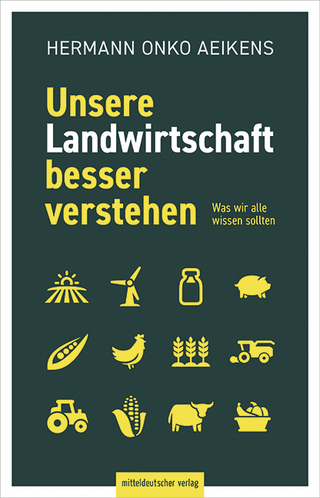
Fermentation Processes: Emerging and Conventional Technologies
Wiley-Blackwell (Verlag)
978-1-119-50585-3 (ISBN)
Fermentation Processes reviews the application of both conventional and emerging technologies for enhancing fermentation conditions, examining the principles and mechanisms of fermentation processes, the microorganisms used in bioprocesses, their implementation in industrial fermentation, and more. Designed for scientists and industry professionals alike, this authoritative and up-to-date volume describes how non-conventional technologies can be used to increase accessibly and bioavailability of substrates by microorganisms during fermentation, which in turn promotes microbial growth and can improve processes and productivity across the agri-food, nutraceutical, pharmaceutical, and beverage industries.
The text begins by covering the conventional fermentation process, discussing cell division and growth kinetics, current technologies and developments in industrial fermentation processes, the parameters and modes of fermentation, various culture media, and the impact of culture conditions on fermentation processes. Subsequent chapters provide in-depth examination of the use of emerging technologies—such as pulsed electric fields, ultrasound, high-hydrostatic pressure, and microwave irradiation—for biomass fractionation and microbial stimulation. This authoritative resource:
Explores emerging technologies that shorten fermentation time, accelerate substrate consumption, and increase microbial biomass
Describes enhancing fermentation at conventional conditions by changing oxygenation, agitation, temperature, and other medium conditions
Highlights the advantages of new technologies, such as reduced energy consumption and increased efficiency
Discusses the integration and implementation of conventional and emerging technologies to meet consumer and industry demand
Offers perspectives on the future direction of fermentation technologies and applications Fermentation Processes: Emerging and Conventional Technologies is ideal for microbiologists and bioprocess technologists in need of an up-to-date overview of the subject, and for instructors and students in courses such as bioprocess technology, microbiology, new product development, fermentation, food processing, biotechnology, and bioprocess engineering.
MOHAMED KOUBAA, ESCOM, UTC, EA 4297 TIMR, Compiègne, France. FRANCISCO J. BARBA, Faculty of Pharmacy, Preventive Medicine and Public Health, Food Science, Toxicology and Forensic Medicine Department, Universitat de València, València, Spain. SHAHIN ROOHINEJAD, Burn & Wound Healing Research Center, Shiraz University of Medical Science, Shiraz, Iran.
Chapter 1. Introduction to conventional fermentation processes
1. 1. Bioprocesses
1.1.1. Production of microbial biomass
1.1.2. Production of microbial metabolites
1.1.3. Production of microbial enzymes
1.1.4. Production of recombinant proteins
1.1.5. Production of microbial plasmids
1.1.6. Bioconversion
1.2. Energetic metabolism
1.2.1. Energy transfer and redox reactions
1.2.2. Aerobic respiration
1.2.3. Anaerobic respiration
1.2.4. Fermentation
1.3. Microorganisms used in fermentation processes
1.3.1. Bacteria
1.3.2. Fungi
1.4. Fermentation technology
1.5. Conclusions
1.6. References
Chapter 2. Current developments in industrial fermentation processes
2.1. Introduction
2.2. Main achievements in industrial fermentation
2.2.1. Fermentation processes in food industry
2.2.1.1. Alcoholic beverages
2.2.1.2. Enzymes
2.2.2. Fermentation processes in chemical industry
2.2.2.1. Biofuels
2.2.2.2. Organic acids
2.2.2.3. Triacylglycerols and Polyhydroxyalkanoates
2.2.2.4. Syngas fermentation
2.2.3. Fermentation processes in the pharmaceutical industry
2.2.3.1. Drugs
2.2.3.2. Recombinant proteins
2.3. Current developments in industrial fermentation
2.3.1. Microorganisms
2.3.2. Fermentation Media
2.3.2.1. Types of media sources
2.3.3. Fermentation systems
2.3.3.1. Solid-state fermentation bioreactors
2.3.3.2. Ultrasonic fermentation process
2.3.3.3. Electro fermentation
2.3.4. Fermentation optimization
2.3.5. Fermentation process modeling
2.3.5.1. Mechanistic models
2.3.5.2. Computational fluid dynamics (CFD)
2.3.6. Inhibition of fermentation processes
2.3.6.1. Substrate inhibition
2.3.6.2. pH inhibition
2.3.6.3. Inhibition by un-dissociated acids
2.3.6.4. Temperature inhibition
2.3.6.5. Nitrogen inhibition
2.3.6.6. Inhibition by phosphate
2.3.6.7. Inhibition by sulfide
2.3.6.8. Inhibition by lactic acid bacteria
2.3.6.9. Inhibition by metals
2.3.6.10. Inhibition by phenolic and furanic mixtures
2.4. Conclusions
2.5. References
Chapter 3. Culture condition changes for enhancing fermentation processes
3.1. Introduction
3.1.1. Fermentation
3.2. Culture media used for fermentation
3.2.1. The culture media purpose
3.2.2. Media types
3.2.3. Culture media: a quantitative approach
3.2.4. Culture media: a compositional approach
3.2.4.1. Water
3.2.4.2. Energy sources
3.2.4.3. Carbon sources
3.2.4.4. Examples of commonly used carbon sources
3.2.4.5. Nitrogen sources
3.2.4.6. Minerals
3.2.4.7. Chelators
3.2.4.8. Growth factors
3.2.4.9. Buffers
3.2.4.10. Precursors and metabolic regulators to media
3.2.4.11. Precursors and inhibitors
3.2.5. Impact of culture conditions on fermentation processes
3.2.5.1. The temperature
3.2.5.2. The pH
3.2.5.3. The cell concentration
3.2.5.4. The carbon dioxide
3.2.5.5. The ethanol
3.3.1. Pasteur effect
3.3.2. Crabtree effect
3.3.3. Custer effect
3.3.4 Oxygen requirements
3.4. Conclusions
3.5. References
Chapter 4. Emerging technologies and their mechanism of action on fermentation
4.1. Introduction
4.2. High hydrostatic pressure (HHP) processing
4.3. Ultrasound (US)
4.4. Pulsed Electric Fields
4.5. Microwaves (MV)
4.6. Conclusions
4.7. References
Chapter 5. Biomass fractionation using emerging technologies
5.1. Introduction
5.2. Ultrasound application for biomass fractionation
5.3. Microwave application for biomass fractionation
5.4. Pulsed-electric fields application for biomass fractionation
5.5. Enzyme-assisted fractionation of biomass
5.6. Supercritical fluid fractionation of biomass
5.7. Conclusions
5.8. References
Chapter 6. Enhancing microbial growth using emerging technologies
6.1. Introduction
6.2. Microbial stimulation using electric fields
6.3. Microbial stimulation using ultrasounds
6.4. Microbial stimulation using high pressure
6.5. Conclusions
6.6. References
| Erscheinungsdatum | 23.09.2019 |
|---|---|
| Verlagsort | Hoboken |
| Sprache | englisch |
| Maße | 170 x 244 mm |
| Gewicht | 567 g |
| Themenwelt | Naturwissenschaften ► Biologie |
| Technik | |
| ISBN-10 | 1-119-50585-2 / 1119505852 |
| ISBN-13 | 978-1-119-50585-3 / 9781119505853 |
| Zustand | Neuware |
| Haben Sie eine Frage zum Produkt? |
aus dem Bereich


